Duration: 7 days
Day 1
Moscow → Zelenograd (30 km.) → Klin (~60 km.) → Yamuga (~8 km.) → Zavidovo (~18 km.) → Mokshino (~8 km.) → Emmaus (~40 km.) → Pominovo (~40 km.) → Tver (~20 km.) → Torzhok (~60 km.) → Valdai monastery (~160 km.) → Veliky Novgorod (~140 km.)
Zelenograd (30 km. from Moscow).
- Zelenograd literally means ‘green city’. It is a young city founded in 1958 on a previously empty, forested place. Today Zelenograd is a part of Moscow having deep links with Sanskrit.
- During the Soviet period Zelenograd was a closed city. It was one of the most powerful centers of electronics, microelectronics and computer industry in the Soviet Union. It still plays a similar role in modern Russia. Zelenograd was developed as a reflection of the California Silicon Valley.
- Zelenograd is twinned with Tulsa (United States). It is situated on the Arkansas River in northeast Oklahoma, a region of the state known as ‘Green Country’. For most of the 20th century, Tulsa held the nickname ‘Oil Capital of the World’ and played a major role as one of the most important hubs for the American oil industry. Another Tulsa’s nickname is the «Birthplace of Route 66». In 1925, Tulsa businessman Cyrus Avery began his campaign to create a road linking Chicago to Los Angeles. He had the same name with Cyrus the Great (600 – 530 BCE).
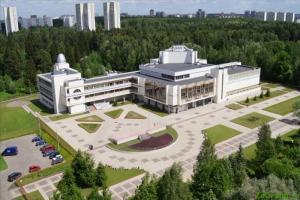
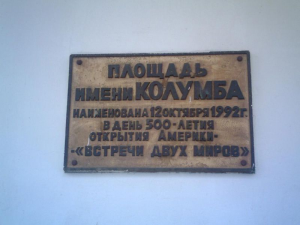 Zelenograd is liked to America not only by the Silicon Valley and Tulsa. In Zelenograd there is a square named after Christopher Columbus (1451 – 1506) who initiated the permanent European colonization of the New World. His father in law was a Portuguese Knight of Santiago, navigator and explorer. In 1992, on the day of the 500th anniversary of the discovering of America for the Europeans, the square in Zelenograd was named after Christopher Columbus to memorize the Spanish sailors whose 23 graves were found during the building here the Zelenograd Palace of Children and Youth Creativity. Also, the workers found the remains of a medieval Spanish settlement, two small cannons, typical Spanish helmets, navigational instruments, several gold doubloons of the late 15th century. During the Reykjavik Summit (1986) with U.S. President Ronald Reagan, Mikhail Gorbachev agreed to transfer all the found items to the Spanish government, whose interests, as NATO ally, were defended by Reagan. It is believed the Spaniards identified Christopher Columbus among them. It is known fact that the square received its name at the request of the Spanish ambassador, who asked the then mayor of Zelenograd to perpetuate the place where the last expedition of this great navigator ended. This brave story states that Christopher Columbus (being a Christianized Jew) had been looking for the Ten Lost Tribes of Israel. He was disappointed after his four expeditions to the West. The local people (Indians) did not resemble the descendants of the Jews. Then Columbus decided to equip the fifth expedition, this time to the East…
Zelenograd is liked to America not only by the Silicon Valley and Tulsa. In Zelenograd there is a square named after Christopher Columbus (1451 – 1506) who initiated the permanent European colonization of the New World. His father in law was a Portuguese Knight of Santiago, navigator and explorer. In 1992, on the day of the 500th anniversary of the discovering of America for the Europeans, the square in Zelenograd was named after Christopher Columbus to memorize the Spanish sailors whose 23 graves were found during the building here the Zelenograd Palace of Children and Youth Creativity. Also, the workers found the remains of a medieval Spanish settlement, two small cannons, typical Spanish helmets, navigational instruments, several gold doubloons of the late 15th century. During the Reykjavik Summit (1986) with U.S. President Ronald Reagan, Mikhail Gorbachev agreed to transfer all the found items to the Spanish government, whose interests, as NATO ally, were defended by Reagan. It is believed the Spaniards identified Christopher Columbus among them. It is known fact that the square received its name at the request of the Spanish ambassador, who asked the then mayor of Zelenograd to perpetuate the place where the last expedition of this great navigator ended. This brave story states that Christopher Columbus (being a Christianized Jew) had been looking for the Ten Lost Tribes of Israel. He was disappointed after his four expeditions to the West. The local people (Indians) did not resemble the descendants of the Jews. Then Columbus decided to equip the fifth expedition, this time to the East…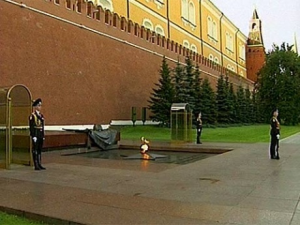 Zelenograd is famous not the only for remains of the Spaniards. Practically in the same time with their discovery, Zelenograd incorporated (1988) the former village of Kryukovo that was one of the most important places during the Battle of Moscow (October 1941 – January 1942). From Zelenograd land the remains of the Unknown Soldier were taken for reinterment at the Kremlin Wall in the Alexander Garden in Moscow. The earliest tradition of the Eternal flame is attributed to Zoroastrianism and the above mentioned Achaemenid era of Persian history. The birthplace of Zoroaster is also unknown. One strong candidate is Bronze Age settlement Arkaim in the Southern Urals, a centre of the Indo-Aryan migration into India, Iran and Mesopotamia. Another version states that Zoroaster was born at the confluence of the Kama and Chusovaya rivers, near the modern Russian city of Perm.
Zelenograd is famous not the only for remains of the Spaniards. Practically in the same time with their discovery, Zelenograd incorporated (1988) the former village of Kryukovo that was one of the most important places during the Battle of Moscow (October 1941 – January 1942). From Zelenograd land the remains of the Unknown Soldier were taken for reinterment at the Kremlin Wall in the Alexander Garden in Moscow. The earliest tradition of the Eternal flame is attributed to Zoroastrianism and the above mentioned Achaemenid era of Persian history. The birthplace of Zoroaster is also unknown. One strong candidate is Bronze Age settlement Arkaim in the Southern Urals, a centre of the Indo-Aryan migration into India, Iran and Mesopotamia. Another version states that Zoroaster was born at the confluence of the Kama and Chusovaya rivers, near the modern Russian city of Perm.
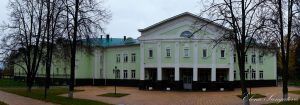 Klin has been known since the beginning of 14th century.
Klin has been known since the beginning of 14th century.- The town is best known as the residence of the most famous Russian composer Pyotr Ilyich Tchaikovsky (1840 — 1893). He was the first Russian composer whose music made a lasting impression internationally, bolstered by his appearances as a guest conductor in Europe and the United States. Tchaikovsky was born in Votkinsk, today most famous for its Machine Building Plant producing some of Russia’s long-range ballistic missiles. In the 1840s, under the supervision of Tchaikovsky’s farther, the enterprise was reprofiled from purely metallurgical to machine-building.
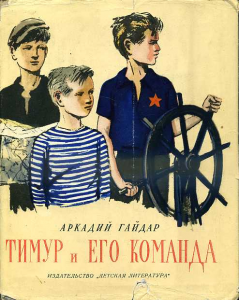 The most recognized children’s writer of the Soviet Union Arkady Gaidar (1904 – 1941) lived and worked in Klin. Here he wrote his most famous books about good, faith and justice. From his books the Timur movement was born. It was an altruistic youth volunteering movement in the Soviet Union. It was a state supported form of socially useful activity of children, contributing to their moral education and development of initiative. The name of the movement is linked to the founder of the Timurid Empire in Persia and Central Asia. The descendants of Timur (1370 — 1405) ruled the Indian subcontinent from 1555 to 1857. Timur was
The most recognized children’s writer of the Soviet Union Arkady Gaidar (1904 – 1941) lived and worked in Klin. Here he wrote his most famous books about good, faith and justice. From his books the Timur movement was born. It was an altruistic youth volunteering movement in the Soviet Union. It was a state supported form of socially useful activity of children, contributing to their moral education and development of initiative. The name of the movement is linked to the founder of the Timurid Empire in Persia and Central Asia. The descendants of Timur (1370 — 1405) ruled the Indian subcontinent from 1555 to 1857. Timur was 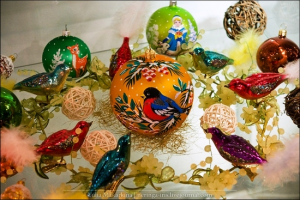 invincible military and political leader raised from nowhere. Notably, his personal seal had the symbol of Shambala. It is still on the coat of arm of Samarkand that was Timur’s capital city.
invincible military and political leader raised from nowhere. Notably, his personal seal had the symbol of Shambala. It is still on the coat of arm of Samarkand that was Timur’s capital city.- Klin is the hometown of glass Christmas tree toys. The main Russian Christmas tree in Kremlin is decorated only with these toys. Near the famous factory of Christmas-tree toys is the source of river Yamuga.
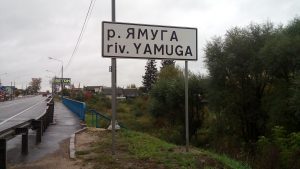 The Yamuga River crosses twice the federal highway M-10 that connects Moscow and Saint-Petersburg. Russian village Delhi is located 130 km. north-west of Yamuga.
The Yamuga River crosses twice the federal highway M-10 that connects Moscow and Saint-Petersburg. Russian village Delhi is located 130 km. north-west of Yamuga.- Yamuna is the Hindu sacred river. India’s capital Delhi and its previous capital Agra stand on the banks of Yamuna River. Agra is also the site of magnificent Taj Mahal.
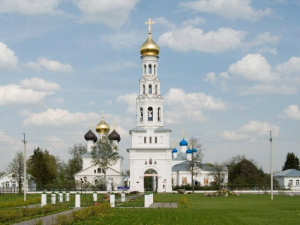 Zavidovo is a specially protected natural area of federal significance with the status of a national park. Also, it is the place of state residence ‘Rus’ of the President of Russia.
Zavidovo is a specially protected natural area of federal significance with the status of a national park. Also, it is the place of state residence ‘Rus’ of the President of Russia.- In the 16th century Zavidovo was the place of a hunting hut of the first Russian tsar (close to star) Ivan the Terrible. Stalin (1879 – 1953) considered him as his teacher. In 1951, Zavidovo became a state residence on Stalin’s decree.
- In the 1920s, Lenin loved to come to the local forests for spring hunts.
Mokshino (8 km. from Zavidovo)
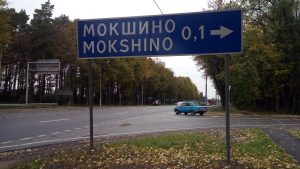 Moksha is often understood as spiritual liberation. It refers to freedom from the cycle of death and rebirth (saṃsara) as well as freedom from ignorance. Russian has a number of settlements and river that have root ‘Moksha‘, came from the Sanskrit word ‘Moska‘.
Moksha is often understood as spiritual liberation. It refers to freedom from the cycle of death and rebirth (saṃsara) as well as freedom from ignorance. Russian has a number of settlements and river that have root ‘Moksha‘, came from the Sanskrit word ‘Moska‘.- Moska is very close the name of river Moskva on which Russian capital Moskva (eng. Moscow) is located.
- The Moksha Dwara (Door to Salvation) is the name of the main entrance (north entrance) of the Dwarkadhish temple in Indian city Dwarka. According to tradition, it has been built over Lord Krishna’s residential place.
- Mokshino is located on the crossroad of the federal highway M-10 and the road to the neighboring villages Varaksino and Shosha. Near Mokshino Lama River flows into Shosha River. In Tibetan Buddhism, Lama is a title for a teacher of the Dharma. It is similar to the Sanskrit term guru. The Lama’s source is ~90 km. from the center of Moscow.
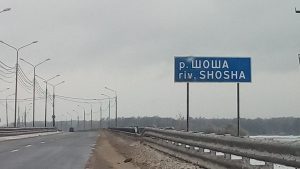 As it is said above, the Lama River is a tributary of the Shosha River. In Hinduism, Shesha (Sanskrit Sesa) is the nagaraja or king of all nagas and one of the primal beings of Creation. Spiritual nagas are known as true masters and teachers of human evolution. Lord Vishnu reclines on the celestial snake, the Shesha-naga. In Sanskrit, naga means cobra, i.e. serpent / reptile with a hood. Cobra is a symbol of Kundalini that is the latent spiritual energy in the human body. Kundalini could give enlightenment and a range of supernormal powers.
As it is said above, the Lama River is a tributary of the Shosha River. In Hinduism, Shesha (Sanskrit Sesa) is the nagaraja or king of all nagas and one of the primal beings of Creation. Spiritual nagas are known as true masters and teachers of human evolution. Lord Vishnu reclines on the celestial snake, the Shesha-naga. In Sanskrit, naga means cobra, i.e. serpent / reptile with a hood. Cobra is a symbol of Kundalini that is the latent spiritual energy in the human body. Kundalini could give enlightenment and a range of supernormal powers.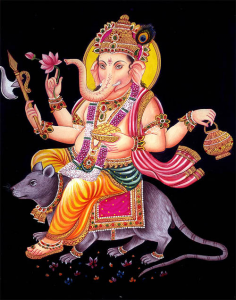
- At the confluence of the Shosha and the Volga there is village Shosha that is a part of rural settlement called Vahonino. The last two letters (‘no’) point only to the status of a settlement. The root is ‘Vahoni’. In Sanskrit, Vahana means ‘that which carries, that which pulls’. Hindu deities use vahana (animal or mythical entity) as a vehicle. For instance, Indian deity Ganesha has a mouse as his vehicle, i.e. vahana. Ganesha is a son of Siva. Russian river Siva that is a tribute of the Kama River. Kama is Sanskrit name of love god. Russian Kama River is a tributary of the above mentioned Volga River.
- In the New Testament, Emmaus is the settlement where Jesus is said to have appeared after his death and resurrection. Emmaus existed as a village in Palestine until 1967, located approximately 30 km west of Jerusalem. Due to its strategic position, Emmaus played an important administrative, military and economic role in the region at certain points of its history. During the late Roman and Byzantine periods Emmaus’s status grew to that of a city (“polis”) and it was named “Nicopolis” (lit. “City of Victory”).
- Village Pominovo is the motherland of Vladimir Putin’s family. Russian surname Putin is related to the
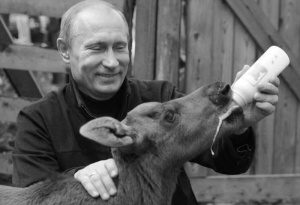 word “putnik” that is “traveler”. In Sanskrit, it is pathika. The Russian word “put” means “way, road”. In Sanskrit, “put” means “virtue”, whereas “puta” means “purifying”, “who purifies”, etc.
word “putnik” that is “traveler”. In Sanskrit, it is pathika. The Russian word “put” means “way, road”. In Sanskrit, “put” means “virtue”, whereas “puta” means “purifying”, “who purifies”, etc.
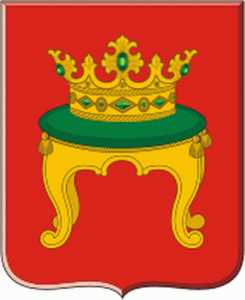 Tver was formerly the capital of a powerful medieval state. It was Moscow’s rival for the supremacy over the whole Russian lands. It is depicted on the Tver’s coat of arm.
Tver was formerly the capital of a powerful medieval state. It was Moscow’s rival for the supremacy over the whole Russian lands. It is depicted on the Tver’s coat of arm.- Tver is situated at the conflux of three rivers, including the Volga River (3700 km. long). The point of such confluence is a sacred place for Hindus. The most famous is Prayag (Allahabad). It is the second-oldest city in India. In the 16th century the Mughal emperor Akbar the Great (a descendant of the above mentioned Timur) named if after his syncretic religion (Din-i Ilahi, lit. “Religion of God”) intending to merge the best elements of the religions of his empire (Islam, Hinduism, Christianity, Jainism, Sikhism, Zoroastrianism), and thereby reconcile the differences that divided his subjects. Allahabad was the birthplace of Jawaharlal Nehru and his daughter Indira Gandhi.
- Tver is often associated with dver and dwerka that are Russian words for door, gate, etc. In Sanskrit, door is dvara. Dwarka is one of the four sacred Hindu pilgrimage sites and one of the seven most ancient religious cities of India.

- The first European who reached India was Tver citizen Afanasiy Nikitin by sailing the Volga River, the Caspian Sea, the Persian Gulf, etc.
- It is said that India’s first Prime Minister Jawaharlal Nehru helped Soviet leader Nikita Khrushchev to take decision to erect a monument of Nikitin. The surname Nehru correlates to the name of Lake Nero in Rostov Velikiy.
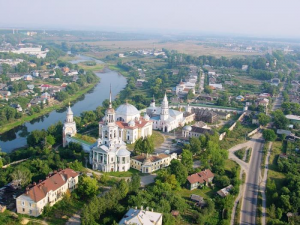 Torzhok was first mentioned in a chronicle in 12th It used to be an important trade center.
Torzhok was first mentioned in a chronicle in 12th It used to be an important trade center.- Architectural monuments of Torzhok include a number of churches and an old monastery redesigned in Neoclassical style. There is also Russian Empress Catherine the Great’s travel palace (18th century).
- 25 km. north-east from Torzhok is the village Berezai. According to the Avesta (the primary collection of religious texts of Zoroastrianism), Hara Berezaiti is the legendary mountain around which the stars and planets revolve. In Avestan cosmogony, Hara Berezaiti (literally meaning “High Watchpost”) is the geographic center of the universe, immediately surrounded by the steppes of the homeland of the early Iranians.
Valdai monastery (160 km. from Torzhok)
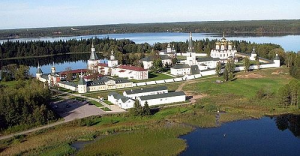 Valdai Iversky monastery is located on an island of the Valdai Lake.
Valdai Iversky monastery is located on an island of the Valdai Lake.- The monastery was founded in the middle of 17th century by Nikon, the seventh Patriarch of the Russian Orthodox Church. Nikon said that the Paradise is in the Sky, but on Earth there is Valday. Nikon founded this monastery in Russia in the image of the Iberian monastery on Mount Athos (the monastic state) in northern Greece. So the Valdai Iversky monastery derives its name from the Iveron monastery of Mount Athos.
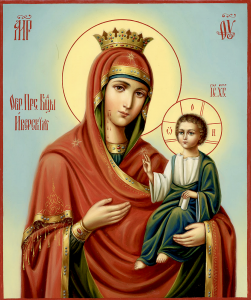 The Iveron monastery was built under the supervision of two Georgian monks in the 10th century and housed Georgian clergy and priests. Iveron literally means “of the Iberians” in Greek. The name Iveron was originated from the ancient Georgian Kingdom of Iberia (Iveria) where the master architect of the monastery was from. The Iveron monastery ranks among the top in the hierarchy of the Athonite monasteries. The wonderworking Iveron icon of the Virgin Mary is the main treasure of the Iveron monastery, where it is believed to have been since the end of 10th century.
The Iveron monastery was built under the supervision of two Georgian monks in the 10th century and housed Georgian clergy and priests. Iveron literally means “of the Iberians” in Greek. The name Iveron was originated from the ancient Georgian Kingdom of Iberia (Iveria) where the master architect of the monastery was from. The Iveron monastery ranks among the top in the hierarchy of the Athonite monasteries. The wonderworking Iveron icon of the Virgin Mary is the main treasure of the Iveron monastery, where it is believed to have been since the end of 10th century.- Nikon commissioned an exact copy of the Iveron icon to be made and sent to Russia. The Iverskaya Chapel was built to enshrine the icon. The chapel was the main entrance to Red Square and traditionally everyone, from the Tsar down to the lowest peasant would stop there to venerate the icon before entering the square.
- Nikon also held position of Archimandrite of Novospassky monastery patronized by the Russian Tsars. It is the Romanovs family shrine. Among the last Romanovs buried in the monastery were Xenia Shestova (the mother of the first Romanov Tsar), Princess Tarakanova (a daughter of Empress Elisabeth) and Grand Duke Sergei Alexandrovich of Russia, an influential figure during the reigns of his brother Emperor Alexander III of Russia and his nephew Emperor Nicholas II, who was also his brother in law through Sergei’s marriage to Elizabeth, who was the elder sister of Nicholas’ wife Alexandra. Both Elizabeth and Alexandra were granddaughters of Queen Victoria who was named Alexandrina in honor of one of her godfathers, Emperor of Russia Alexander I, and Victoria in honor of his mother. The Victorian era became the period of industrial, cultural, political, scientific and military development of Great Britain and the time of greatest prosperity of the British Empire.
- Valdai is also the home of official residence of the President of the Russian Federation. It is also called Uzhin after the other nearest lake. Uzhin is a complex term. Ujjain is one of the legendary sacred sites of the Buddhists and the Hindus, center of Hinduism and Sanskrit learning. Its location is still an open question. In the central India, in Madhya Pradesh state, there is Ujjain, one of the holiest cities in India, and place of mass Hindu pilgrimage during the Kumbh Mela festival that is considered as the world’s largest congregation of religious pilgrims. The exact age of the festival is uncertain. According to medieval Hindu mythology, Lord Vishnu dropped drops of Amrita (the drink of immortality) at four places, while transporting it in a kumbha (pot). Ujjain was one of them. The Aquarian holds two pots (or kumbha) on the coat of arm of the Russian town Veliky Ustyug, the place of spiritual deeds of the Romanovs’ family. Ujjain was the first territory of Ashoka (268 — 232 BC) who is internationally recognized as one of the preeminent rulers in the human history. He spread Buddhism in India and other counties, created the largest empire ever in the Indian subcontinent and one of the world’s largest empires at that time.
- Some brave researches compare the Valdai Hills to the Mount Meru from Mahabharata (major Sanskrit epic of ancient India) and mountain Hara from the ancient Iranian book Avesta. According to the Avesta, the rivers Ra, Rusija, Ardvi-Sura run down the Hara. The Valdai is a place of many lakes and the origin of the largest European rivers: the Volga (~3700 km.), the Dnieper (2 145 km.), the Desna (1130 km.), the Western Dvina (1020 km.), etc.
- The Valdai Hills (>600 km.) is the natural watershed of three seas: the Caspian Sea (the Volga), the Black Sea (the Dnieper) and the Baltic Sea (the Western Dvina, etc.). This ridge stretches in the latitudinal direction ‘from sunset to sunrise’, i.e. ‘from west to east’. It is important. Interestingly, the Avesta and the Rig Veda as well as ancient historians constantly repeated that the sacred Hara, Meru and the Riphean mountains stretched from west to east.
- It is well known fact that the early Iranians and the Indians (i.e. the so called Arias) came from the north. Geographically speaking, the Valdai Hills (and Russia as a whole) is the north to Iranian plateau and Indian subcontinent.
- Valdai is the birthplace of Yuri Roerich (1902 — 1960), a prominent 20th century Tibetologist, the oldest son of the painter and explorer Nicholas Roerich and Helena Roerich. They spent many years living in India and finding its links with Russia.
Veliky Novgorod (140 km. from Valdai)
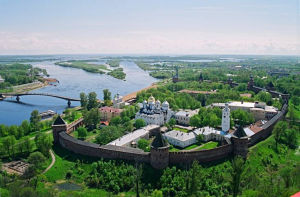 Veliky Novgorod, also known as Novgorod the Great, is one of the most important historic cities in Russia. The city lies along the river Volkhov (Eng. Magician) just downstream from its outflow from Lake Ilmen that Europe’s 11th natural lake. 11 is the number of the Aquarius in Zodiac. The coming Aquarius Age is believed to bring new Golden Age to the planet.
Veliky Novgorod, also known as Novgorod the Great, is one of the most important historic cities in Russia. The city lies along the river Volkhov (Eng. Magician) just downstream from its outflow from Lake Ilmen that Europe’s 11th natural lake. 11 is the number of the Aquarius in Zodiac. The coming Aquarius Age is believed to bring new Golden Age to the planet.- Veliky Novgorod is considered to be the cradle of the Russian statehood. The Rurik Dynasty was established here in the 9th century. The Rurikids are one of Europe’s oldest royal houses. They were the founders of the Tsardom of Russia and the ruling dynasty until 17th century when they were succeeded by the above mentioned Romanovs.
- In the 12th century, the ancestor of the Romanovs Imperial House, Saint Procopius the Blessed, came to Veliky Novgorod from Prussia. At that time he was a wealthy Prussian merchant and prince. He and his family were forced to escape their home in Prussia (the Baltic Sea) after the strikes of Teutonic knights christening the western slaves with sword. There are several versions of his spiritual mission in Russia. Procopius took monastic vows in Veliky Novgorod and became a monk. Later he moved from Veliky Novgorod to Veliky Ustyug to perform his spiritual deeds. His son Andrei established himself in Moscow. His descendants became the Romanovs and ruled Russia from 1613 to 1917. Procopius is still the only Russian saint depicted on icons with three sticks in his hand. It corresponds to the ancient Egyptian hieroglyph set meaning “gods”. The Procopius’ three sticks may also represent the number 777 that is significant in various religious and political contexts.
- The most popular Veliky Novgorod folk hero is Sadko.
- Novgorod used to be a center of magi. Their prime deity Veles stands behind the founder of the Russian statehood in the bronze monument ‘Millennium of Russia’ in Novgorod Kremlin.
Night in Veliky Novgorod
Day 2
Veliky Novgorod → Saint-Petersburg (~250 km.) → Sortavala (~300 km.)
Saint-Petersburg (~250 km. from Veliky Novgorod):
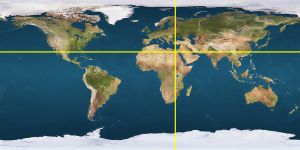 Saint-Petersburg was the Russian capital from 1712 to 1918. It stands on the so-called Nile Meridian or 30th meridian (around 30°N latitude), Earth’s ancient Prime Meridian. On this same meridian are located the greatest places and cities of the world: Giza (the home of the great pyramids and the Sphinx), Akhetaton (Amarna), Cairo, Constantinople (Istanbul), Kiev and Saint-Petersburg. Their foundation was always followed by a new loop of development of the civilization. The circumstances of the appearance of these new capitals are always the same. So, they could be parts of one big plan. Interestingly, the foundation correlates to the movement of the Orion Correlation.
Saint-Petersburg was the Russian capital from 1712 to 1918. It stands on the so-called Nile Meridian or 30th meridian (around 30°N latitude), Earth’s ancient Prime Meridian. On this same meridian are located the greatest places and cities of the world: Giza (the home of the great pyramids and the Sphinx), Akhetaton (Amarna), Cairo, Constantinople (Istanbul), Kiev and Saint-Petersburg. Their foundation was always followed by a new loop of development of the civilization. The circumstances of the appearance of these new capitals are always the same. So, they could be parts of one big plan. Interestingly, the foundation correlates to the movement of the Orion Correlation.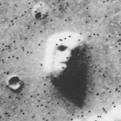 Almost all the ancient civilizations known to modern science, appeared and developed along the above 30th parallel. Moreover, the pyramids and face on Mars are also located along the 30th parallel. Along the 30th parallel on Earth are the following ancient cities and places:
Almost all the ancient civilizations known to modern science, appeared and developed along the above 30th parallel. Moreover, the pyramids and face on Mars are also located along the 30th parallel. Along the 30th parallel on Earth are the following ancient cities and places:
- Eridu — the first city built by Nibiruans on Earth. Eridu was located in southern Mesopotamia (near Basra of modern Iraq). Eridu is believed to be the oldest city in the world, a proposed location of the Garden of Eden. In Sumerian mythology, Eridu was originally the home of Enki, deity of creation.
- Saint Catherine’s Monastery at the foot of Mount Sinai — one of the oldest working Christian monasteries in the world. It has the world’s oldest continually operating library. Sinai’s pre-Christian history is quite interesting. Sinai is associated with Ninhursag, sister of Enki. In Sumerian religion, she was a mother goddess of the mountains, and one of the seven great deities of Sumer. Her name Ninhursag literally means “lady of the sacred mountain” and correlates to Sinai. Her other names are Mamma or Mami (mother) that symbolize her role in creation.
- Petra (Jordan) — a mysterious city and the capital of the Edomites, who were the pre-Jewish population of Jerusalem and the only people in the world who were subjected to forcible conversion to Judaism by the Jewish king and High Priest John Hyrcanus from the Hasmonean dynasty (in the 2nd century BCE). The Edomites had lived in this area from the second half of the 2nd millennium BCE. They lost the beautiful lands of Canaan (including Jerusalem) to the Jews, and then became an active part of the Jewish people. Famous Edomites include Herod the Great, who built the Second Temple. His most famous fortress was Masada, one of the Jewish people’s greatest symbols as the place where the last Jewish stronghold against Roman invasion stood in the 1st century.
- Persepolis — the capital of the huge Achaemenid Empire, founded by Cyrus the Great (600 – 530 BCE). It that was one of the largest empires in history. The empire of Cyrus the Great is equally notable for its very successful model of a centralized administration and establishing a government working to the advantage and profit of its subjects. Alexander the Great, a passionate admirer of Cyrus the Great, conquered most of the empire by 330 BC and took over the Cyrus’ model. He respected the customs and religions of the lands he conquered. Cyrus the Great is the only non-Jew who is called as Messiah (lit. ‘His anointed one’). The Cyrus Cylinder discovered in the ruins of Babylon is called the first declaration of universal human rights. Russian has many cities, settlements, streets, factories, etc. named after Cyrus or Kirov (1886–1934) who was a Russian revolutionary and head of the Communist party organization in Leningrad (Saint-Petersburg). Mausoleum of Cyrus the Great, along with the Mayan pyramid in Palenque, served as an architectural prototype of Lenin’s mausoleum on the Red Square. Lenin was the leader of the Communist revolution that took place in Saint-Petersburg in 1917.
- Harappa — the capital of one of the ancient civilizations of mankind, along with Egyptian and Sumerian civilizations.
- Kurukshetra — one of the most sacred places in India. According to Hindu beliefs, the Battle of Kuruksetra took place here more than 5000 years ago. Before the battle began, Lord Krishna revealed “Bhagavad Gita” (“Song of God”). It presents the basic essence of Hindu philosophy and is one of the most valued spiritual and philosophical texts in the world.
- Kulu — the valley of the gods (India), in which the Roerichs lived and worked for a long time, summarizing the findings of their spiritual expeditions.
- Kailas — the heart of Tibet and the holy place of four religions — Hinduism, Buddhism, Jainism and the ancient Tibetan teachings of Bon. In fact, Kailas is a regular tetrahedral pyramid, whose top is rounded and covered with a cap of eternal ice.
- Lhasa — the holy of holies and the capital of Tibet, which at all times was the edge of forbidden secrets.
- Chinese pyramids of Shaanxi Province, located within a radius of about 100 km. around the city of Xi’an and others.
- The Bermuda Triangle — one of the most mysterious and paranormal places on Earth.
- Beside the 30th meridian, Saint-Petersburg lies on one 60th parallel (of northern latitude), i.e. on one line with all Scandinavian capitals. These cities share approximately the same distance equal in radial measures to a step of 7 degrees in latitude: Oslo — 10°45’east longitude; Stockholm / Uppsala — 17°39’E; Helsinki — 24°56’E; Saint-Petersburg — 30°19’E.
- Only Saint-Petersburg enjoys the cross of the 60th parallel with 30th meridian or Nile Meridian.
- To the west of Scandinavia, the 60th parallel crosses a small archipelago, the Orkney and Shetland Islands that belong to Great Britain. They have the highest density of megalithic objects in the world. Moreover, it is thought that these objects are older than the Stonehenge.
- To the east Saint-Petersburg (> 3000 km.), in the Eastern Siberia, 60th parallel is the place of Tunguska event, the largest impact event on Earth in recorded history. It happened in 1908. It is estimated that the Tunguska explosion knocked down some 80 million trees over an area more than 2,000 km2. The estimates of the energy of the air burst vary from 5 to 30 megatons of TNT. The 15 megaton estimate represents energy about 1000 times greater than that of the atomic bomb dropped on Hiroshima, Japan. Magazine «World Channeling» №7 (39) 2017 states that it was special energy arrival to Earth. The area was very important in the time of Lemuria (26,000 years ago). This is a special portal on the planet.
Sortavala (~300 km. from Saint-Petersburg)
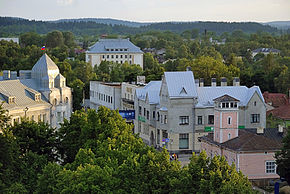 Town Sortavala is located at the north of Lake Ladoga that is the largest lake in Europe.
Town Sortavala is located at the north of Lake Ladoga that is the largest lake in Europe.- The records date Sortavala district to the end of 15th century. In 1990, it was awarded the status of historic town of Russia.
- 30 km. north of Sortavala is Ruskeala, picturesque former marble quarries. The quarries have supplied marble to decorate the most impressive cathedrals and palaces in Saint-Petersburg. The length is 460 meters; width is up to 100 meters. The distance from the highest point of the pit to its bottom is over 50 meters. Transparency of water reaches 15-18 meters.
Night in Sortavala
Day 3
Sortavala ↔ Valaam Island of Lake Ladoga (~40 km. one way on a speedboat)
Sortavala → Petrozavodsk (~250 km.)
Valaam monastery & Lake Ladoga
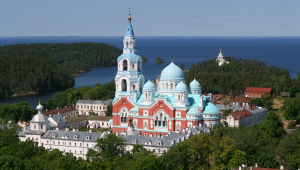 Valaam monastery is located on the Valaam that is largest island in Lake Ladoga. The monastery was founded in 14th century.
Valaam monastery is located on the Valaam that is largest island in Lake Ladoga. The monastery was founded in 14th century.- In the 12th century, Valaam was a part of the Novgorod Republic (see above Veliky Novgorod).
- The natural beauty of Valaam, its old monastery and the unique climate have made the island a beloved place of Russian emperors and the President of the Russian Federation.
- The etymology of name “Valaam” is uncertain, like the etymology of name Balaam, a diviner in the Torah (Law of Moses written in the first five books of the Bible). In Russian, Balaam is Valaam.
- It is sad that in rabbinic literature Balaam / Valaam is represented as one of seven non-Jew prophets. In the ancient Levant, Baal (Russian Vaal) meant “lord”, “god”, etc. The Vaal River is the largest tributary of the Orange River in South Africa.
Petrozavodsk
- The city stretches along the western shore of Lake Onega, the second largest lake in Europe after the above mentioned Lake Ladoga.
- Petrozavodsk was founded in 1703 like Saint-Petersburg, but archeological discoveries in the urban area indicate the presence of a settlement as far back as 7000 years ago.
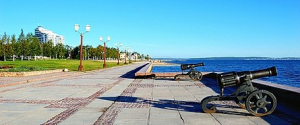 Petrozavodsk was initially developed to manufacture cannons for the Russian army. Experts claim that the first railway in the world was inaugurated for industrial uses of the local foundry in 1788.
Petrozavodsk was initially developed to manufacture cannons for the Russian army. Experts claim that the first railway in the world was inaugurated for industrial uses of the local foundry in 1788.- Petrozavodsk is distinguished among other towns of North Russia by its Neoclassical architectural heritage.
- Petrozavodsk used to have the most expensive street in the world in terms of material. After the WWII, one of the longest city streets was paved with Crimson quartzite mined on the western shore of Lake Onega, 60 km. from Petrozavodsk. The second name of this rock is royal stone. It used for the sarcophagus of Napoleon Bonaparte (Paris), for decoration of Saint-Petersburg’s top landmarks, Lenin’s Mausoleum on the Red Square in Moscow, etc. See below Shoksha.
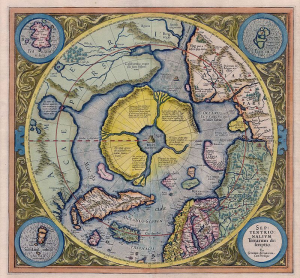 Petrozavodsk hosts the International Competition of Snow and Ice Sculptures. This winter festival is called “Hyperborea”. Its name is borrowed from ancient Greek mythology, where Boreas is the god of the north wind, and the country “Hyperborea” is “the country beyond the North Wind”. This land was supposed to be perfect, with the sun shining twenty-four hours a day. Modern esoteric thought states that Hyperborea was the Golden Age polar center of civilization and spirituality.
Petrozavodsk hosts the International Competition of Snow and Ice Sculptures. This winter festival is called “Hyperborea”. Its name is borrowed from ancient Greek mythology, where Boreas is the god of the north wind, and the country “Hyperborea” is “the country beyond the North Wind”. This land was supposed to be perfect, with the sun shining twenty-four hours a day. Modern esoteric thought states that Hyperborea was the Golden Age polar center of civilization and spirituality.
- The idea to organize winter festival “Hyperborea” was born in 2001 at the Forum of Cities of the 60th Parallel. Russia has created its civilization and culture in the climate of the 60th parallel that is not too far from the Arctic Circle.
- The idea of the festival is to present an attractive side of life in the North, the development of cultural exchange between cities, where winter is the main season.
- More than half of Russia’s territory lies above the 60th parallel. This geographic area is generally considered to be unsuitable for “normal” life and people’s activities. However, over 5% of the Russia’s population lives around the 60th parallel. In this aspect, Russia is indeed a unique country. For instance, Anchorage located on the 61st parallel, is the most northern city in the US. Anchorage is the largest city in Alaska and counts for 40% the state’s total population. Nevertheless, Anchorage’s population is only 0,1% of the U.S. total. Alaska occupies not less than 16% of the total territory of the United States, but its population is only about 0,2% of the population of this country. In Canada, the northern territories are about 40% of the total area of the country. Their population is only 0,02% of Canada’s total. Canada’s most populous agglomeration (Toronto) is located only on the 43rd parallel. Ottawa, the capital city of Canada, is sited on the 45th parallel as well as Montreal, the second-most populous city in Canada.
- The majority of the most important Russian cities (including Moscow) are located approximately at the 55th parallel. Over 25% of Russia’s population lives around the 55th parallel. In comparison, in Western Europe, to the north of this parallel, are only the Scandinavian countries and Scotland “heated” by the Gulf Stream. Their population is relatively small.
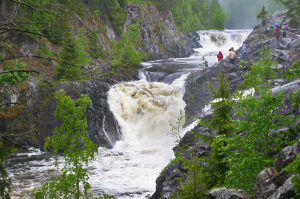 80 km. north of Petrozavodsk there is cascade waterfall Kivach. Kivach has long been considered as the largest plain waterfall in Russia and the second largest plain waterfall in Europe after the Rhine River (the Rhine, Switzerland). After building a dam in 1936 (for the local hydroelectric power station), the former power of Kivach waterfall is lost. Interestingly, Kivach waterfall is located on the Suna River. In Arabic, Sunna means “habit” or “usual practice”. The Sunna (Eng. Sunnah) is the verbally transmitted record of the teachings, deeds and sayings, silent permissions (or disapprovals) of the Islamic prophet Muhammad. The Koran (the holy book of Islam) and the Sunna make up the two primary sources of Islamic theology and law. Lake Sandal is ~ 10 km. from the waterfall Kivach. Sandalwood is an aromatic plant and the second most expensive wood in the world, right after African Blackwood. Sandal is found in India, Australia, Indonesia, and the Pacific Islands. Its use is integral part of daily practices of the oldest religions, such us Hinduism, Jainism, Buddhism, Zoroastrianism, etc. Indian Sandal is very sacred in the Ayurveda, the medical science of Ancient India that deals with matters relating to health, day-to-day life and longevity (long life).
80 km. north of Petrozavodsk there is cascade waterfall Kivach. Kivach has long been considered as the largest plain waterfall in Russia and the second largest plain waterfall in Europe after the Rhine River (the Rhine, Switzerland). After building a dam in 1936 (for the local hydroelectric power station), the former power of Kivach waterfall is lost. Interestingly, Kivach waterfall is located on the Suna River. In Arabic, Sunna means “habit” or “usual practice”. The Sunna (Eng. Sunnah) is the verbally transmitted record of the teachings, deeds and sayings, silent permissions (or disapprovals) of the Islamic prophet Muhammad. The Koran (the holy book of Islam) and the Sunna make up the two primary sources of Islamic theology and law. Lake Sandal is ~ 10 km. from the waterfall Kivach. Sandalwood is an aromatic plant and the second most expensive wood in the world, right after African Blackwood. Sandal is found in India, Australia, Indonesia, and the Pacific Islands. Its use is integral part of daily practices of the oldest religions, such us Hinduism, Jainism, Buddhism, Zoroastrianism, etc. Indian Sandal is very sacred in the Ayurveda, the medical science of Ancient India that deals with matters relating to health, day-to-day life and longevity (long life).
Night in Petrozavodsk
Day 4
Petrozavodsk ↔ Kizhi Island of Lake Onega (~60 km. one way on a speedboat)
Petrozavodsk → Vytegra (~220 km.)
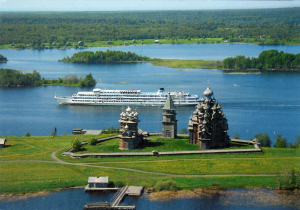 The main attraction of Onega Lake is the island of Kizhi in the northern part of the lake. There are 89 wooden architectural monuments of 15th–20th centuries on the island. The most remarkable of those is the early 18th century complex consisting of a summer 22-dome church, a winter 9-dome church and a belfry. It was included in the list of UNESCO World Heritage cites in 1990.
The main attraction of Onega Lake is the island of Kizhi in the northern part of the lake. There are 89 wooden architectural monuments of 15th–20th centuries on the island. The most remarkable of those is the early 18th century complex consisting of a summer 22-dome church, a winter 9-dome church and a belfry. It was included in the list of UNESCO World Heritage cites in 1990.- Lake Onega’s length is ~ 245 km and width ~ 90 km. The deepest place (127 meters) is located in the northern part, whose banks are rocky. Onega Lake basin is a major source of granite and marble in Russia which have been exploited in the area since the early 18th century.
- The Onega contains a well-developed navigation system which is part of the Volga–Baltic Waterway and White Sea – Baltic Canal, connecting the basins of Baltic, Caspian and the northern seas. These canals allow water transport of goods from the lake to the countries from Germany to Iran.
- 58 rivers and more than 110 tributaries flow into the lake, but only one river named Svir, flows out of the lake. This Svir River runs from the southwestern shore of Lake Onega to Lake Ladoga and continues as the Neva River to Saint-Petersburg and the Gulf of Finland. In Sanskrit, the word “Svar” has several celestial meanings, including: “the region of the planets and constellations”, “the Sun”, “the light”, “space above the Sun or between the Sun and the Polar star”, “Heaven”, etc.
- Another attraction of the lake is Onega petroglyphs (rock engravings). They are located on the eastern coast of the lake and date back to 4th –2nd millennia BCE. There are about 1200 petroglyphs scattered over the 20 km. area including several capes.
Shoksha (~60 km. from Petrozavodsk)
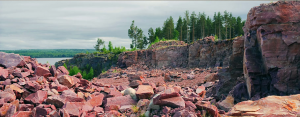 Shoksha is a village on the western shore of Lake Onega. It contains a unique quarry of red and pink quartzite (Crimson quartzite) that has been used in finishing a significant number of monuments of worldwide significance in Saint-Petersburg, Moscow, Paris, etc. It is more than four times harder than granite. After polishing, Crimson quartzite also called Purple porphyry will maintain the high gloss for six centuries.
Shoksha is a village on the western shore of Lake Onega. It contains a unique quarry of red and pink quartzite (Crimson quartzite) that has been used in finishing a significant number of monuments of worldwide significance in Saint-Petersburg, Moscow, Paris, etc. It is more than four times harder than granite. After polishing, Crimson quartzite also called Purple porphyry will maintain the high gloss for six centuries.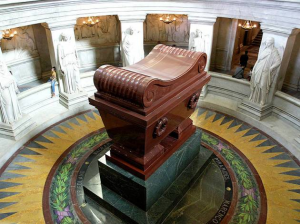 In 19th century France asked Russian Emperor Nicolas I to supply purple porphyry (crimson quartzite) from Shoksha for the tomb of Napoleon at Les Invalides (Paris). The Russian Emperor said “What a strange fate… In the struggle with Russia, Napoleon lost his glory, and Russia is building him a tombstone”. In 12 years later, the monument to the Russian Emperor Nicolas I himself was placed on a pedestal decorated with the same purple porphyry (crimson quartzite) from Shoksha.
In 19th century France asked Russian Emperor Nicolas I to supply purple porphyry (crimson quartzite) from Shoksha for the tomb of Napoleon at Les Invalides (Paris). The Russian Emperor said “What a strange fate… In the struggle with Russia, Napoleon lost his glory, and Russia is building him a tombstone”. In 12 years later, the monument to the Russian Emperor Nicolas I himself was placed on a pedestal decorated with the same purple porphyry (crimson quartzite) from Shoksha.- The Presidential patio in the Moscow Kremlin is made of purple porphyry (crimson quartzite) from Shoksha. They say that products made of crimson quartzite have an imperial style. Rather, it is a style of statehood, a style of power.
- In Hinduism, Shesha (Sanskrit Sesa) is the nagaraja or king of all nagas and one of the primal beings of Creation. Spiritual nagas are known as true masters and teachers of human evolution. Lord Vishnu reclines on the celestial snake, the Shesha-naga. In Sanskrit, naga means cobra, i.e. serpent / reptile with a hood. Cobra is a symbol of Kundalini that is the latent spiritual energy in the human body. Kundalini could give enlightenment and a range of supernormal powers.
Vytegra (160 km. from Shoksha)
- Town Vytegra located in the southern area of Lake Onega along the shores of the Vytegra River on Volga–Baltic Waterway.
Night in Vytegra
Day 5
Vytegra → Belozersk (~190 km.) → Goritsy (~45 km.) → Kirillov (~8 km.) → Feropontovo (~20 km.) → Vologda (~120 km.)
Belozersk & Lake Beloye
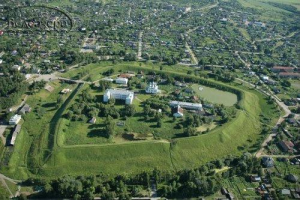 This town located on the southern bank of Lake Beloye (Eng. White Lake), from which it takes the name.
This town located on the southern bank of Lake Beloye (Eng. White Lake), from which it takes the name.- Lake Beloye or White Lake is the 7th natural lake in Europe (by size). God created everything in six, 24-hour days and on the seventh day He rested. This original creation was perfect, without sin or death (Genesis 1).
- The lake has a rounded shape, its length is ~46 km. and the width is ~32 km. The average depth of the lake is 5-7 meters. The largest is 20 meters.
- 17 rivers flow into the lake, and only one the Sheksna River flows out (the basin of river Volga and the Caspian Sea).
- Interestingly, among the above mentioned tributaries of Lake Beloye, is the Kema River. The main tributary of the Kema River is the Indomanka River. Its root ‘Indoman’ could be translated from Sanskrit, where ‘indhana’ means ‘Indian’. The Kema River flows out of Lake Kemskoye. Kemet (or km) was the name of ancient Egypt in Egyptian.
- Belozersk was first chronicled in 862 as one of the five original Russian towns. Belozersk was an important center of international trade.
- According to a chronicle, Sineus became the prince of Beloozero in 862. He was a brother of Rurik, the founder of the Rurik Dynasty which ruled Russia until the end of 16th century. They were succeeded by the Romanovs.
- From the 10th to the 13th centuries, the territory was controlled by the Novgorod Republic. See above Veliky Novgorod (Lake Ilmen). In 14th century the Beloozero principality became subordinate to the Grand Duchy of Moscow.
- In the course of the administrative reform carried out in the beginning of 18th century by Peter the Great, Beloozero was included into Saint Petersburg Governorate.
- Belozersk is located on the 60th parallel, like Saint Petersburg and the Scandinavian capitals (see above). Interestingly, Belozersk founded in 862 is the oldest of them. The capital of Finland Helsinki was founded in 1550 as a trading town. Russian Emperor Alexander I of Russia, the defeater of the above mentioned Napoleon, moved the Finnish capital from Turku to Helsinki in 1812. Oslo, the capital of Norway, was founded around 1049 as a trading place. Around the year 1300 Oslo was elevated to a capital. The earliest written mention of the name Stockholm (Sweden’s capital) dates from 1252, although the Old Town of Stockholm was first built from about 1000 by Vikings on their trade routes. It was also the time of the last zenith of Old Uppsala, the first capital of Sweden and the main pagan center. Saint Petersburg was founded in 1703 at the crossing of the 60th parallel with 30th or Nile meridian.
Goritsky monastery & Maura Hill (~45 km. from Belozersk)
- Click Goritsky monastery
Kirillo-Belozersky monastery
Ferapontov monastery
- Click Ferapontov monastery
Night in Vologda
Day 6
Vologda → Kostroma (~280 km.) → Yaroslavl (~85 km.) → Rybinsk (~80 km.) → Tutayev (~50 km.) → Rostov Veliky (~90 km.).
Kostroma (~280 km. from Vologda)
- Click Kostroma
Yaroslavl (~85 km. from Kostroma)
- Click Yaroslavl
Rybinsk (~80 km. from Yaroslavl)
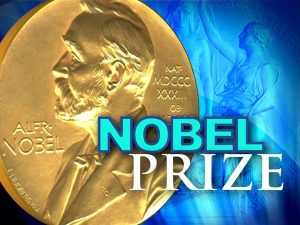 The name of Alfred Nobel is known all over the world. Get a Nobel Prize is the dear dream of any scientist. But not many people know that the Alfred Nobel and his brothers made their fortune in Russia. Based in Rybinsk in the 19th century, they became the founders of Russian big oil business. The Nobels successfully competed with the American Rockefeller and the European Rothschilds. There are only two museums dedicated to Nobels in the world. One is in Sweden, the homeland of the Nobel brothers, the second is in Rybinsk.
The name of Alfred Nobel is known all over the world. Get a Nobel Prize is the dear dream of any scientist. But not many people know that the Alfred Nobel and his brothers made their fortune in Russia. Based in Rybinsk in the 19th century, they became the founders of Russian big oil business. The Nobels successfully competed with the American Rockefeller and the European Rothschilds. There are only two museums dedicated to Nobels in the world. One is in Sweden, the homeland of the Nobel brothers, the second is in Rybinsk.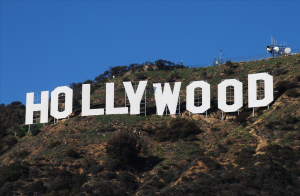 Rybinsk was the home town of the brothers Joseph and Nicholas Schenck who became the founders of Hollywood. Remarkably, the people who made Hollywood were Jew immigrants from different parts of the Russian Empire. For instance, the family of Joseph and Nicholas migrated to America from Rybinsk in 1893. The Schenck brothers founded Metro studios — Goldwin — Mayer and XX Century, which together with Columbia Pictures and Warner Brothers were the main film companies of Hollywood in the last century.
Rybinsk was the home town of the brothers Joseph and Nicholas Schenck who became the founders of Hollywood. Remarkably, the people who made Hollywood were Jew immigrants from different parts of the Russian Empire. For instance, the family of Joseph and Nicholas migrated to America from Rybinsk in 1893. The Schenck brothers founded Metro studios — Goldwin — Mayer and XX Century, which together with Columbia Pictures and Warner Brothers were the main film companies of Hollywood in the last century.- Rybinsk Reservoir is a water reservoir on the Volga River and its tributaries Sheksna and Mologa, formed by Rybinsk Hydroelectric Station dam. At the time of its construction, it was the largest man-made body of water on Earth. The length is over 170 km., the width is ~60 km., average depth is ~6 m., and maximum depth is ~30 m. The construction of the dam in Rybinsk started in 1935 and continued until 1947. Thousands of people were gradually resettled elsewhere. The historic town of Mologa along with hundreds of villages have completely disappeared under water. Thus, Mologa is often called Russian Atlantis. Rybinsk Reservoir is the northernmost point of the Volga River, national symbol of Russia.
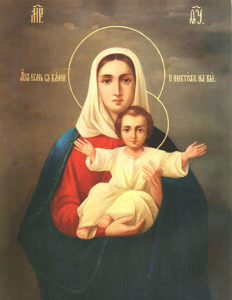 The Rybinsk Reservoir has hidden under its waters many Russian churches and monasteries, including the famous Leushinsky monastery. The monastery was founded in 1875 and became one of the favorites of the three
The Rybinsk Reservoir has hidden under its waters many Russian churches and monasteries, including the famous Leushinsky monastery. The monastery was founded in 1875 and became one of the favorites of the three 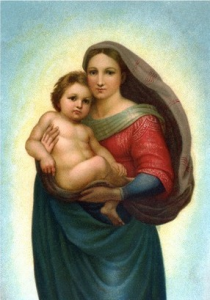 main Russian women’s monasteries. Its main shrine (sacred object) was the icon of Praise of the Mother of God. The literal name of the icon is “I am always with you and no one will offend you”. SaintJohn of Kronstadt (1829 — 1908), known for his spiritual insight and powerful prayers, called the icon the Savior of Russia. The prototype of this icon is the Sistine Madonna of the Italian artist Raphael (1483 — 1520). Together with Michelangelo and Leonardo da Vinci, he forms the traditional trinity of great masters of the High Renaissance.
main Russian women’s monasteries. Its main shrine (sacred object) was the icon of Praise of the Mother of God. The literal name of the icon is “I am always with you and no one will offend you”. SaintJohn of Kronstadt (1829 — 1908), known for his spiritual insight and powerful prayers, called the icon the Savior of Russia. The prototype of this icon is the Sistine Madonna of the Italian artist Raphael (1483 — 1520). Together with Michelangelo and Leonardo da Vinci, he forms the traditional trinity of great masters of the High Renaissance.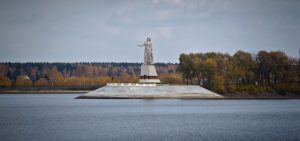 Monument “Mother Volga” stands at the Rybinsk dam. Her right arm is stretched towards the above mentioned Rybinsk reservoir (at the time of its construction, it was the largest man-made body of water on Earth). In her left arm she holds a document. There is no single opinion on what this document is. In the iconostases of Russian Orthodox churches, saints are depicted with scrolls with prophecies. The best poem dedicated to the Volga was written by Rybinsk born famous Soviet poet Lev Oshanin (1912-1996). It became the famous Soviet song “The Volga River flows”. His surname has Sanskrit roots. In Sanskrit, ‘osana’ means ‘sharp flavour’, whereas ‘osani’ is ‘kind of vegetable’. Lev Oshanin and Alexei Leonov (the first human performed spacewalk) were born on May 30.
Monument “Mother Volga” stands at the Rybinsk dam. Her right arm is stretched towards the above mentioned Rybinsk reservoir (at the time of its construction, it was the largest man-made body of water on Earth). In her left arm she holds a document. There is no single opinion on what this document is. In the iconostases of Russian Orthodox churches, saints are depicted with scrolls with prophecies. The best poem dedicated to the Volga was written by Rybinsk born famous Soviet poet Lev Oshanin (1912-1996). It became the famous Soviet song “The Volga River flows”. His surname has Sanskrit roots. In Sanskrit, ‘osana’ means ‘sharp flavour’, whereas ‘osani’ is ‘kind of vegetable’. Lev Oshanin and Alexei Leonov (the first human performed spacewalk) were born on May 30.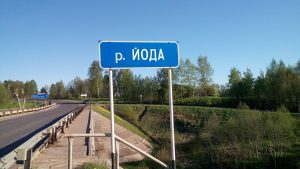 Interestingly, on the outskirt of Rybinsk is former village Israili. ~17 km. from the center of Rybinsk is the source of the Yoda River. In the Star Wars, Yoda is the Grand Master of the Jedi Order. In Sanskrit, ‘yodha’ means ‘warrior’, ‘war’. In Hebrew, ‘yodea’ means ‘I know’. The source of the Yoda River is near the village Levino whose name comes from Levi. In Jewish tradition, a Levite is a member of the Israelite Tribe of Levi, descended from Levi, the third son of Jacob (later given the name Israel) and Leah. Aaron and Moses were from this tribe. The Tribe of Levi served particular religious duties for the Israelites and had political responsibilities. It is believed by some that among the Levites hid the Egyptian priests who sought to rule the world.
Interestingly, on the outskirt of Rybinsk is former village Israili. ~17 km. from the center of Rybinsk is the source of the Yoda River. In the Star Wars, Yoda is the Grand Master of the Jedi Order. In Sanskrit, ‘yodha’ means ‘warrior’, ‘war’. In Hebrew, ‘yodea’ means ‘I know’. The source of the Yoda River is near the village Levino whose name comes from Levi. In Jewish tradition, a Levite is a member of the Israelite Tribe of Levi, descended from Levi, the third son of Jacob (later given the name Israel) and Leah. Aaron and Moses were from this tribe. The Tribe of Levi served particular religious duties for the Israelites and had political responsibilities. It is believed by some that among the Levites hid the Egyptian priests who sought to rule the world.-
The Aaronic priesthood was colloquially named kohen or cohen. They are traditionally believed to be of direct patrilineal descent from Aaron, brother of Moses. Kohanim can also refer to the Jewish nation as a whole in terms that the people of Israel were chosen (on Sinai) to lead humanity to perfection and the descendants of Levi were destined to be pioneers in the people of Israel. Interestingly, the noun kohen is used in the Torah to refer to priests, whether Jewish or pagan, such as the kohanim (‘priests’) of Baal or Dagon. It is believed that the word ‘kohen’ derives from a Semitic root. The cognate Arabic word ‘kahin’ means ‘oracle’, or ‘priest’. In the Southern Urals, next to Lake Arakul (i.e. Oracle) there are two lakes – Big Kagan and Small Kagan. Russian Arabist Nikolai Vashkevich puts forward the theory that all words of any language of the world are motivated through Russian or Arabic. Vashkevich compares the symbiosis of Russian and Arabic (the “language plasma of the RA”) with the symbiosis of hydrogen and helium, which make up more than 98% of the solar photosphere. He states that Russian and Arabic are the “system languages of the brain”, the “working languages of the subconscious”, regardless of history, geography, ethnic or species belonging. This single working language manifests its cybernetic function, controlling living objects through their names. As a matter of fact, the word ‘Koran’ assumes various meanings in the Quran (Koran) itself. The word ‘Koran’ in the reverse reading gives in the Russian word ‘Narok’ that means the Covenant. Vashkevich shows how the linguistic plasma of the RA (i.e. Russian and Arabic) allows one to see the hidden meaning of objects.
-
After the source near the above mentioned village Levino, the Yoda River passes other villages with distinctive names: Savinskoe (In Sanskrit, ‘sava’ means ‘kind of sacrifice’, ‘sun’, ‘commander’, ‘order’, etc.), Gorki (Gori and Gor or Horus), Kotlovo (In Hindustani language, that is an Indo-Aryan language and the lingua franca of North India and Pakistan, ‘kotla’ means ‘citadel’), etc.
-
Near the mouth of Yoda River there is artificially made triangular shaped water reservoir.
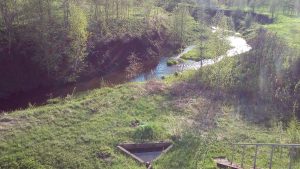 Interesting story of the Pères du Triangle (Fathers of the Triangle), a secret organization that controls world affairs, is given in the books of Maximillien de Lafayette. This mysterious group is said to possess a vast pool of forbidden knowledge, transmitted directly from the Anunnaki. Their home planet is Nibiru, well known from the books of a Russian-American author Zecharia Sitchin (1920 – 2010).
Interesting story of the Pères du Triangle (Fathers of the Triangle), a secret organization that controls world affairs, is given in the books of Maximillien de Lafayette. This mysterious group is said to possess a vast pool of forbidden knowledge, transmitted directly from the Anunnaki. Their home planet is Nibiru, well known from the books of a Russian-American author Zecharia Sitchin (1920 – 2010). 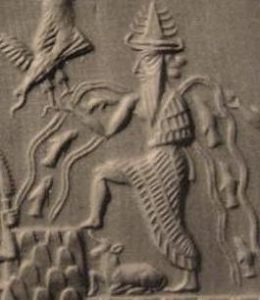 According to his theory and Sumerian mythology, Nibiruan Enki created the man and educated his
According to his theory and Sumerian mythology, Nibiruan Enki created the man and educated his
offsprings. Fish is the symbol of Enki. The literal meaning of the name Rybinsk is ‘fish city’. In the past it was a fishing settlement supplying the Moscow court with sturgeons and other valuable fish.-
Fish is the symbol of the Age of Pisces, also named the Age of
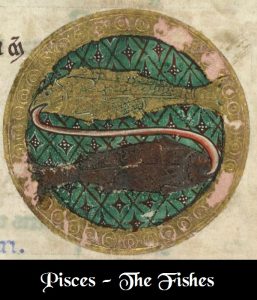 Monotheism (One God) and Abrahamic religions that shaped the world in the previous 2000 year circle. Fish is also a sign of Christ born in the beginning of the Age of Pisces. The Bible makes many references to fish. Jesus is called the Fisher of men. Today, the planet is in the transition from the Piscean Age to the Aquarian Age. The next 2000 years will be notable for universal love, brotherhood and integrity. The only city in the world that has the Aquarius (the Water Carrier) on its coat of arms is Russian town Veliky Ustyug, having a special mission for the whole humanity. Today, Veliky Ustyug is also the capital of Russian New Year rooted in the global mysteries of Ancient Egypt and the Sumerian New Year festival based on the legend of arrival to Earth the representatives of the above mentioned planet Nibiru.
Monotheism (One God) and Abrahamic religions that shaped the world in the previous 2000 year circle. Fish is also a sign of Christ born in the beginning of the Age of Pisces. The Bible makes many references to fish. Jesus is called the Fisher of men. Today, the planet is in the transition from the Piscean Age to the Aquarian Age. The next 2000 years will be notable for universal love, brotherhood and integrity. The only city in the world that has the Aquarius (the Water Carrier) on its coat of arms is Russian town Veliky Ustyug, having a special mission for the whole humanity. Today, Veliky Ustyug is also the capital of Russian New Year rooted in the global mysteries of Ancient Egypt and the Sumerian New Year festival based on the legend of arrival to Earth the representatives of the above mentioned planet Nibiru. -
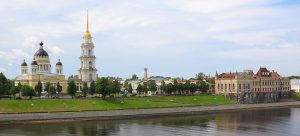 In the 18th century, the Russian Empress Catherine the Great granted the settlement municipal rights and renamed it Rybinsk. Its most conspicuous landmark, the Neoclassical Savior-Transfiguration Cathedral, was constructed on the Volga riverside in the middle of 19th century. Its bell tower is the second tallest in Russia after the bell tower of the Peter and Paul Cathedral in Saint-Petersburg, burial vault of the Romanovs. The Rybinsk Cathedral was built to a design of a Russian architect Avraam Melnikov (1784 — 1854), the Dean of the Russian Academy of Arts in Saint Petersburg, also famous for the two Egyptian sphinxes, made in the time of pharaoh Amenhotep III succeeded by his son Echnaton noted for his reforms and beautiful wife Nefertiti. Initially, Melnikov prepared the design for Saint Isaac’s Cathedral, the main cathedral in Saint-Petersburg, but lost the contest to the French-born architect Auguste de Montferrand. Eventually, Melnikov sold his grandiose design to the municipal authorities of Rybinsk. The name of Avraam Melnikov in English is Abraham, like the Hebrew patriarch Abraham. Abrahamic religions are Judaism, Christianity, and Islam. Judaism influenced Christianity and Islam. At the same time, Judaism was influenced by Zoroastrianism, the Persian imperial religion. But the pioneer of a monotheistic religion that later became Judaism is considered to be the above mentioned Echnaton. One of the first scholars who put forward this idea was Sigmund Freud, the founder of psychoanalysis.
In the 18th century, the Russian Empress Catherine the Great granted the settlement municipal rights and renamed it Rybinsk. Its most conspicuous landmark, the Neoclassical Savior-Transfiguration Cathedral, was constructed on the Volga riverside in the middle of 19th century. Its bell tower is the second tallest in Russia after the bell tower of the Peter and Paul Cathedral in Saint-Petersburg, burial vault of the Romanovs. The Rybinsk Cathedral was built to a design of a Russian architect Avraam Melnikov (1784 — 1854), the Dean of the Russian Academy of Arts in Saint Petersburg, also famous for the two Egyptian sphinxes, made in the time of pharaoh Amenhotep III succeeded by his son Echnaton noted for his reforms and beautiful wife Nefertiti. Initially, Melnikov prepared the design for Saint Isaac’s Cathedral, the main cathedral in Saint-Petersburg, but lost the contest to the French-born architect Auguste de Montferrand. Eventually, Melnikov sold his grandiose design to the municipal authorities of Rybinsk. The name of Avraam Melnikov in English is Abraham, like the Hebrew patriarch Abraham. Abrahamic religions are Judaism, Christianity, and Islam. Judaism influenced Christianity and Islam. At the same time, Judaism was influenced by Zoroastrianism, the Persian imperial religion. But the pioneer of a monotheistic religion that later became Judaism is considered to be the above mentioned Echnaton. One of the first scholars who put forward this idea was Sigmund Freud, the founder of psychoanalysis.
Tutayev (~50 km. from Rybinsk)
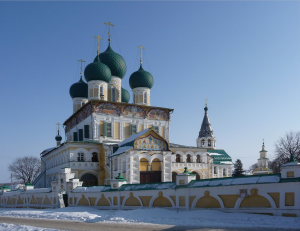 This historic town was founded in 13th century. In the 15th century, it became part of the Grand Duchy of Moscow.
This historic town was founded in 13th century. In the 15th century, it became part of the Grand Duchy of Moscow.- Tutayev is located on the both banks of the Volga River and is very popular with artists.
- Before the Revolution (1917) Tutayev was called Romanov-Borisoglebsk. There is a public movement to return the town its historic name. Tutayev was the surname of a Red Army soldier killed in the area in 1918.
- The Tutayev district is the motherland of Fyodor Ushakov, the most illustrious Russian naval commander and admiral of the 18th century. He was the absolute winner of all naval battles. In the course of 43 naval battles under his command he did not lose a single ship and never lost a battle, none of his subjects were ever captured by the enemy. There was a saying “where the Ushakov, there is a victory”. But first he defeated himself, his human weaknesses, becoming kind and honest, brave
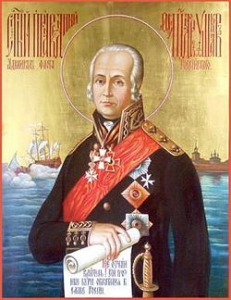 and modest, merciful to his enemies, etc. He completely abandoned his personal interests, devoting his life to his country. His relics are preserved in Sanaksar monastery located on the Moksha River (the Volga basin). In Hindu philosophy, Moksha refers to spiritual liberation from from saṃsara, the cycle of death and rebirth. Also, Moksha refers to freedom from ignorance, self-realization and self-knowledge. The Russian Orthodox Church glorified Admiral Ushakov as a patron saint of the Russian Navy in 2000. He was also declared the patron saint of Russian nuclear-armed strategic bombers in 2005 by Patriarch Alexius II. On his icons, Admiral Ushakov is depicted with a note with his saying regarding the destiny of Russia: “Do not despair! These terrible storms will turn to the glory of Russia”. The root of surname Ushakov is ‘usha’. In Sanskrit, usa means ‘aurora, dawn, morning light’, etc. Interestingly, sanskrit word usa is also an abbreviation for the United States of America. St. Germain and other Ascended Masters had such vision for the destiny of the USA upon its foundation in XVIII century.
and modest, merciful to his enemies, etc. He completely abandoned his personal interests, devoting his life to his country. His relics are preserved in Sanaksar monastery located on the Moksha River (the Volga basin). In Hindu philosophy, Moksha refers to spiritual liberation from from saṃsara, the cycle of death and rebirth. Also, Moksha refers to freedom from ignorance, self-realization and self-knowledge. The Russian Orthodox Church glorified Admiral Ushakov as a patron saint of the Russian Navy in 2000. He was also declared the patron saint of Russian nuclear-armed strategic bombers in 2005 by Patriarch Alexius II. On his icons, Admiral Ushakov is depicted with a note with his saying regarding the destiny of Russia: “Do not despair! These terrible storms will turn to the glory of Russia”. The root of surname Ushakov is ‘usha’. In Sanskrit, usa means ‘aurora, dawn, morning light’, etc. Interestingly, sanskrit word usa is also an abbreviation for the United States of America. St. Germain and other Ascended Masters had such vision for the destiny of the USA upon its foundation in XVIII century. 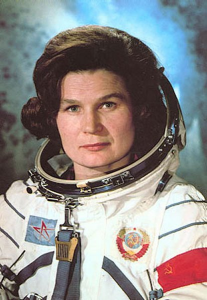
- Tutayev’s magnificent main cathedral is popular with Russian astronauts. It is largely due to Valentina Tereshkova, the first woman to have flown in Cosmos. She was born in the Tutayev district in 1937. Before her recruitment as a cosmonaut, she was an amateur skydiver and textile factory worker. Her husband was another famous Soviet cosmonaut Andriyan Nikolayev (1929 – 2004).
- Tutayev (Romanov-Borisoglebsk) is known for its domestic Romanov sheep. The distribution of this unique breed is worldwide. Romanov wool is very strong and resourceful.
Rostov Veliky (~90 km. from Tutayev)
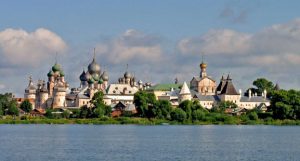 Rostov Veliky or Rostov the Great is one of the oldest Russian towns. It is located on the shores of Lake Nero. Nehru (spelt Neru) was the surname of the first Prime Minister of India after the Independence. His daughter (Indira Gandhi) was the 3rd Prime Minister of India succeeded by her son Rajiv Gandhi.
Rostov Veliky or Rostov the Great is one of the oldest Russian towns. It is located on the shores of Lake Nero. Nehru (spelt Neru) was the surname of the first Prime Minister of India after the Independence. His daughter (Indira Gandhi) was the 3rd Prime Minister of India succeeded by her son Rajiv Gandhi.
Night in Rostov Veliky
Day 7
Rostov Veliky → Porechye (~17 km.) → Osokino (~20 km.) → Osurovo (~20 km.) → Pereslavl (~15 km.) → Sergiev Posad (~70 km.) → Moscow (~70 km.).
Varnitskiy monastery (~4 km. from Rostov Veliky)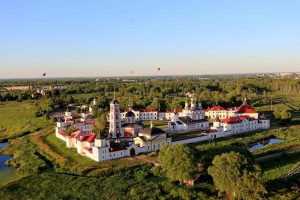
- The monastery was founded by the Archbishop of Rostov in 1427 at the birthplace of St. Sergius of Radonezh (1314 – 1392), one of the most revered Russian saints.
Porechye (~20 km. from Varnitskiy monastery)
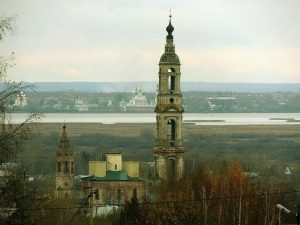 In comparison to Rostov Kremlin, Porechye is located on the opposite side of Lake Nero.
In comparison to Rostov Kremlin, Porechye is located on the opposite side of Lake Nero.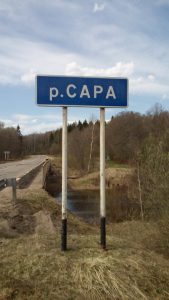
- Porechye is the mouth of the Russian river Sara flowing here into Lake Nero. In Sanskrit, the word Sara means
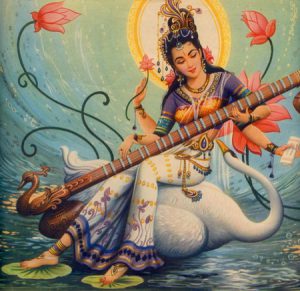 ‘essence‘. Saraswati is ‘one who leads to essence of self knowledge’.
‘essence‘. Saraswati is ‘one who leads to essence of self knowledge’. - Also, Sara (Sarah) is the wife of Abraham in the Hebrew Bible, the Christian Old Testament, and the Islamic Koran. Abraham is the common patriarch of the three Abrahamic religions: Judaism, Christianity, and Islam. Abraham, originally Avram or Abram, was a Sumerian, like his ancestors. In fact, Christianity and Islam have come out of Judaism, which, in turn, is rooted in the heritage of Sumer and Nibiruans. The main Sumerian festival was the New Year. It was dedicated to the arrival of Nibiru and its ‘gods’. The capital town of the Russian New Year is Velikiy Ustyug founded in the 12th century by the residents of Rostov the Great. Another remarkable significance of Ustyug is the Aquarian on its coat of arm. It is the symbol of the coming new cosmic age that will eventually turn out the Golden Age for the planet.
Osokino (~20 km. from Porechye)
- Osokino is connected (via the root of its name) to Asoka, the first Indian Emperor and a great spiritual warrior, one of the best monarchs known in the human history.
Osurovo (~20 km. from Osokino)
- Click Osurovo
Pereslavl (~70 km. from Rostov the Great)
- Click Pereslavl
Sergiev Posad (~70 km. from Pereslavl)
- Click Sergiev Posad
Moscow (~75 km. from Sergiev Posad)
Night in Moscow
